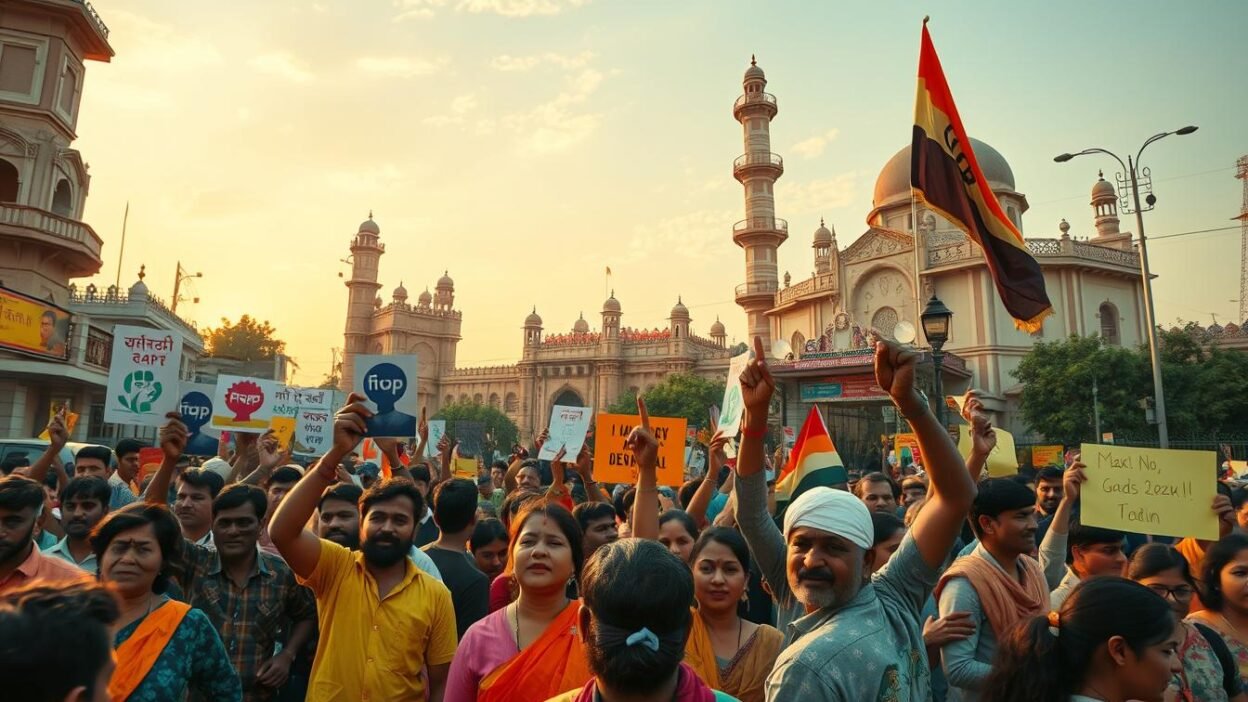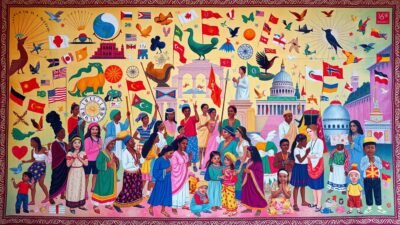What forces are reshaping Political Science’s understanding of citizen activism in India today?
Recently, India has seen a big rise in civil society movements. These include protests against corruption and fights for farmers’ rights. Scholars like Prof Zoya Hasan say this shows a big trust crisis in government. The Carnegie Civic Research Network sees India as a key example of new activism.
This surge shows how civil society is changing democracy. Now, social media is as powerful as old protest methods. This article looks at how these changes meet India’s social and political needs.
Preparing for the UGC NET exam can be a daunting task, but with the right resources, candidates can navigate the process effectively. Websites like MyJRF provide a comprehensive platform for aspiring educators, offering specialized guidance for UGC NET Paper 2 preparation and essential tips for acing UGC NET Paper 1. Additionally, understanding the revised syllabus provided by UGC is crucial for a targeted study approach. For official announcements and updates, candidates should regularly visit the UGC NET NTA portal, while the UGC’s job section and the main UGC website are invaluable for post-exam opportunities and academic resources. With these tools, candidates can maximize their preparation and set themselves up for success. Preparing for Paper 1 and UGC NET Paper 2 Education requires a strategic approach with quality resources. UGC NET Education aspirants can access structured video lectures that cover essential concepts comprehensively. For an in-depth understanding, check out teaching aptitude videos and research aptitude guidance to strengthen your foundation. Additionally, higher education system topics and communication skills preparation are crucial for scoring high. Explore logical reasoning tutorials and mathematical reasoning lectures for better problem-solving skills. Enhance your exam strategy with people, development & environment lessons and ICT in education modules. For previous year papers and practice sessions, explore mock test videos and exam strategy tips. Stay ahead in your preparation with teaching methodology insights and subscribe to Educators Plus for expert guidance.
Key Takeaways
- Civil society movements are redefining Political Science concepts of civic engagement
- Digital platforms amplify traditional activism, altering protest mechanics
- India’s movements reflect global trends while retaining distinct cultural contexts
- Political Science frameworks must adapt to assess hybridized protest strategies
- Academic research highlights the interplay between grassroots demands and policy outcomes
Introduction to Civil Society Movements in India
Civil society movements in India play a big role in shaping our society and politics. They work on their own, outside of the government, to push for change. They help make sure everyone has a say and tackle big problems.
Definition and Scope of Civil Society
Civil society includes groups and efforts that are not part of the government. It covers:
- Community-led advocacy for rights and justice
- Monitoring government policies and their impact
- Working with government to bring about social changes
Historical Context of Civil Society in India
The history of civil society in India is linked to fights against colonial rule and after independence. Important times include:
- Independence Era (1940s): Movements like the Quit India campaign fought against colonial government.
- Post-Independence (1970s-1980s): During the Emergency, civil society stood up against government control through protests and court cases.
- Modern Era (2000s–present): Today, digital tools help movements push for government openness and responsibility.
Public uprisings have historically functioned as correctives to governance failures, argues Prof. Zoya Hasan in her analysis of India’s social movements. “These movements expose gaps in government responsiveness, pushing for equitable policy reforms.”
Key Factors Driving Civil Society Movements
Civil society movements in India come from both home and abroad. Political instability, economic gaps, and global ideas mix together. These elements blend with international relations to shape their actions.
Politics plays a big role. Professor Zoya Hasan points out that when governments fail, people take action. For example, the anti-corruption movement wants leaders to be honest. When some groups feel left out, they protest too.
- Political Landscape: Governance failures and transparency deficits
- Economic Inequality: Rural-urban divides and agrarian crises
- Global Influences: International human rights frameworks and digital activism models
Social and economic gaps cause a lot of anger. Data shows 60% of protests want fair resources. Farmers, for example, are upset about their situation. Their struggles connect to global talks on fairness.
| Factor | Domestic Example | Global Link |
|---|---|---|
| Political Governance | Anti-corruption protests | UN anti-corruption conventions |
| Economic Inequality | Farmer wage disputes | World Bank poverty reduction frameworks |
| Ideological Exchange | Climate justice campaigns | Paris Agreement commitments |
Global ideas also push people to act. Movements learn from others, like Hong Kong’s digital efforts. They use global ideas to make their point, showing how international relations influence local actions.
Notable Civil Society Movements in Recent History
Civil society movements in India have changed public policy through advocacy and grassroots efforts. These efforts show how people coming together can lead to big changes. They connect what people want with new laws.
The Anti-Corruption Movement
In 2011, Anna Hazare’s India Against Corruption (IAC) pushed for accountability. Their efforts led to the 2013 Lokpal Act, a law to fight corruption. They used hunger strikes and online campaigns to push for change.
“Corruption is a moral issue, not just administrative,” Anna Hazare declared, framing the movement’s ethos.
Women’s Rights Movement
Figures like Jyoti Amge and the #MeTooIndia campaign fought for women’s rights. The 2013 Nirbhaya Act and 2017 POCSO amendments show the impact of their work. Groups like CREA helped make laws better for women in schools and workplaces.
Environmental Activism
Protests like the Narmada Bachao Andolan and Chipko Movement protected nature. Laws like the 2006 Forest Rights Act and 2010 National Green Tribunal show their success. Today, they fight against coal mining in Chhattisgarh, showing their ongoing efforts.
| Movement | Key Objective | Policy Impact |
|---|---|---|
| Anti-Corruption | Institutional accountability | Lokpal Act (2013) |
| Women’s Rights | Gender justice | Nirbhaya Act (2013) |
| Environmental | Ecosystem protection | National Green Tribunal (2010) |
These movements show how civil society drives change in public policy. They make sure democracy listens to people’s needs.
The Role of Technology in Mobilizing Activism
Digital tools have changed how we engage in activism. Social media and online platforms are key for organizing and spreading dissent. They help challenge unfair systems.
This change shows a big shift in how movements plan. They mix old-school tactics with new digital ones.
Social Media as a Tool for Change
Platforms like Twitter and Facebook give a voice to the marginalized. Hashtags like #MeTooIndia and #FarmersProtest2021 show how fast ideas can spread. Now, political theory includes “digital mobilization” as a key part of activism.
- Real-time updates help organize protests and raise awareness.
- Algorithms make sure more people see important content, not just a few.
- Virtual support creates global alliances, like in climate activism.
“Digital platforms democratize dissent by lowering barriers to participation,” noted Dr. Ananya Vajpeyi in a 2022 study on Indian activism. “They redefine political theory’s assumptions about power and collective action.”
Digital Platforms and Grassroots Organizing
Tools like WhatsApp and online petitions change how groups plan. They help movements like Save the Internet campaign reach millions. Political theory must now think about how these changes affect power balances.
Platforms also help with data-driven advocacy. For example, apps map pollution or crowdsourced petitions influence policy. These innovations show how tech connects theory and action in today’s activism.
Challenges Faced by Civil Society Organizations
Civil society groups in India face big hurdles. They struggle with rules, money issues, and doubts from the public. These problems make it hard for them to push for change and fight for fairness.
Government Oversight and Regulation
India’s Foreign Contribution (Regulation) Act (FCRA) has made life tough for NGOs. Changes in 2020 made them report more and face harsh penalties if they don’t. This has led to a 40% drop in NGOs from 2015 to 2021, a report by the Centre for Policy Research found in 2022.
Many say these rules are too strict. They think it’s unfair to treat activism as a threat to the country.
Funding and Resource Limitations
NGOs in India get only 12% of their money from local sources, as of 2023. They mostly rely on foreign donations. This makes them very sensitive to changes in government policies.
Here are some key funding problems:
| Issue | Impact |
|---|---|
| FCRA restrictions | Delayed grants and project cancellations |
| Lack of CSR alignment | Only 18% of corporate social responsibility funds reach grassroots groups |
Public Perception and Trust Issues
“Misinformation campaigns have eroded trust in civil society’s role as a watchdog,” noted Dr. Meenakshi Nair, sociologist at Jawaharlal Nehru University.
Only 52% of people trust NGOs now, a Transparency International survey found in 2023. Social media makes things worse by spreading false information. This makes people think activism is not good for the country.
To regain trust, NGOs need to be open and honest in how they work.
Case Studies of Successful Movements
Looking into successful civil society efforts shows us how key they are. Political research helps us see the power of planning and community involvement. The Narmada Bachao Andolan and the Right to Information Movement are great examples of this.
Narmada Bachao Andolan
This movement started in the 1980s to stop the Sardar Sarovar Dam. It aimed to protect tribal communities from being displaced. Medha Patkar led the fight, using legal battles and global advocacy.
They used several strategies:
- Documenting human rights violations through grassroots surveys
- Global campaigns to pressure policymakers
- Legal petitions to halt construction phases
Even though the dam wasn’t completely stopped, the movement changed India’s environmental policies. It made sure community rights were considered in big projects.
Right to Information Movement
The Mazdoor Kisan Shakti Sangathan worked for decades to get the 2005 RTI Act. They focused on:
- Workshops educating marginalized groups about their rights
- Petitions and hunger strikes to demand transparency
- Coalition-building with legal experts and journalists
Political research shows how their efforts led to a law against corruption and secrecy. This law helps people get information from the government.
These movements show us that with the right research and strategies, we can make big changes. Their impact is felt in today’s advocacy efforts.
The Impact of Civil Society on Policy Making
Civil society has changed India’s political systems by turning ideas into laws. Activists use lobbying and public campaigns to make governments listen. This shows how constant effort can lead to big changes in laws.
Advocacy and Lobbying Techniques
Good advocacy means working with lawmakers and using the courts. For example, the Right to Information Act (2005) came from years of work by NGOs, journalists, and lawyers. They showed that openness is important. Grassroots movements use facts to push for policy changes.
Achievements in Legal Reforms
- Environmental Safeguards: Groups like the Narmada protests led to better checks on environmental impact. This made sure projects were green.
- Gender Justice: Women’s rights groups pushed for laws against sexual harassment at work. This was first in the Vishaka Guidelines (1997) and later became law.
- Electoral Reforms: Society checks voter lists and fights corruption. This makes elections fairer.
These wins show civil society’s power in political systems. They make sure laws serve the people, not just the powerful. As legal scholar Upendra Baxi said, “Civil society does not just critique power—it reconstructs it.” This partnership is key to India’s growth as a democracy.
The Future of Civil Society Movements in India
Civil society movements in India are at a turning point. They are influenced by changing political philosophy and new technology. Grassroots activism is meeting digital innovation, showing both hope and doubt. This part looks at new paths and challenges, based on old questions about governance and community involvement.
Emerging Trends and New Initiatives
Today’s movements are becoming more decentralized and networked. Young people are leading campaigns on climate and digital rights. Tools like Twitter and WhatsApp help organize quickly, linking local issues to global conversations on fairness.
Debates on participatory democracy are guiding new ways to make policies. For example, farmer protests are using live streams to organize.
- Technology-Driven Mobilization: AI tools for grassroots mapping and blockchain-based transparency projects.
- Interdisciplinary Alliances: Collaborations between legal experts and NGOs to challenge regressive laws through constitutional interpretations rooted in democratic principles.
Potential Challenges and Areas for Growth
Despite progress, political philosophy is key to overcoming big hurdles. State monitoring of activists and strict NGO laws threaten freedom. Finding lasting funding and passing on leadership to younger generations are essential for survival.
The balance between state power and public dissent is a big challenge. It needs new ways to protect both security and freedom.
“The future lies in reimagining civic spaces as sites of ethical dialogue,” argues Dr. Meera Shetty, a governance scholar at Jawaharlal Nehru University.
To grow, movements must balance idealism with practical steps. They need to rethink what it means to be a citizen and how to keep the movement alive. The answers will shape India’s civic scene for years to come.
Comparative Analysis: India and Global Civil Society Movements
Civil society movements in India share some strategies with global ones. But they also have unique traits shaped by local realities. Studies from the Carnegie Civic Research Network show both similarities and differences in activism worldwide.
Shared Strategies Across Borders
- Digital mobilization: Social media tactics mirror global trends seen in movements like #MeToo and Hong Kong’s protests.
- Grassroots networks: Decentralized organizing strategies parallel Latin American and African civic initiatives.
- Legal advocacy: Use of court systems to drive change aligns with European and North American models.
India’s Distinctive Context
Cultural pluralism shapes India’s movements uniquely. The Bhoomi Kisan Andolan is a good example. It combines traditional farmer solidarity with digital outreach, a model not seen in monocultural societies. Legal frameworks like the Foreign Contribution Regulation Act (FCRA) also create unique challenges, pushing for creative funding solutions.
“India’s movements navigate a dual landscape: hyper-localized issues like caste-based discrimination coexist with global themes of climate justice,” notes the Carnegie study.
While international movements often focus on universal rights, Indian activism often blends religious and cultural narratives. This blend makes movements both globally relevant and deeply rooted in local contexts. It shows how civil society adapts universal principles to fit local needs.
Conclusion: The Importance of Civil Society in Democracy
Civil society movements in India have played a key role in shaping democracy. They challenge unfair systems and bring out the voices of the marginalized. This has led to changes in policies and how people think.
Their efforts, from fighting corruption to protecting the environment, show how people can come together. This bridge helps meet the needs of citizens and the government.
Strengthening Democratic Processes
Democracies need transparency and accountability, which civil society fights for. The Right to Information Act is a great example. It shows how grassroots efforts can lead to more involvement in government.
Legal changes, like those from the Narmada Bachao Andolan, show the power of organized dissent. These efforts make sure policies serve everyone, not just the wealthy.
Encouraging Civic Engagement and Participation
Today, social media has made activism more accessible. It turns ordinary people into change-makers. Hashtags have mobilized millions in various movements.
But, there are challenges like funding and rules. Education and making things easier to access are key to keeping people involved.
A strong democracy needs citizens and institutions working together. Civil society acts as a watchdog and innovator. The future of India’s democracy depends on staying vigilant, adaptable, and united.





